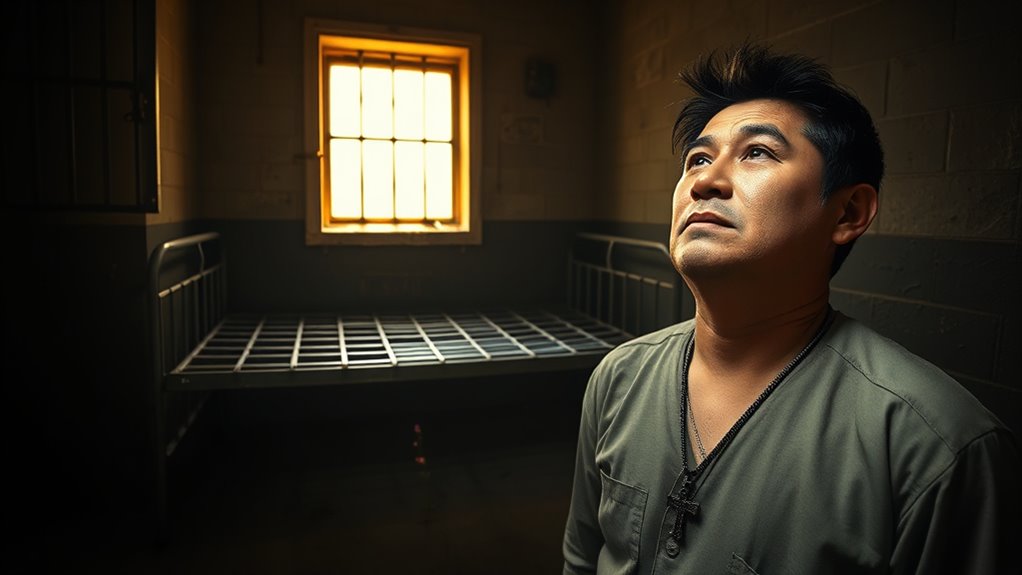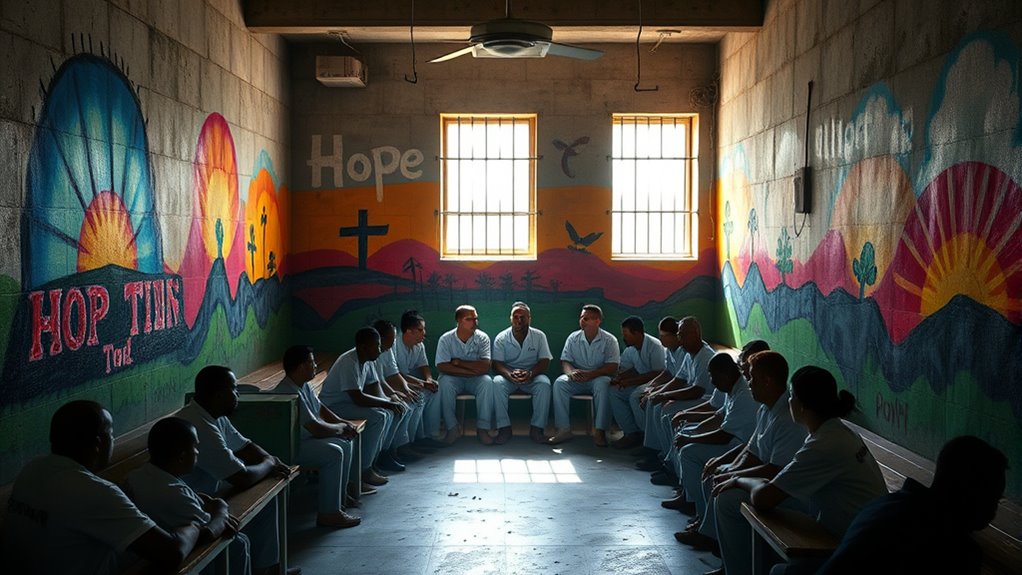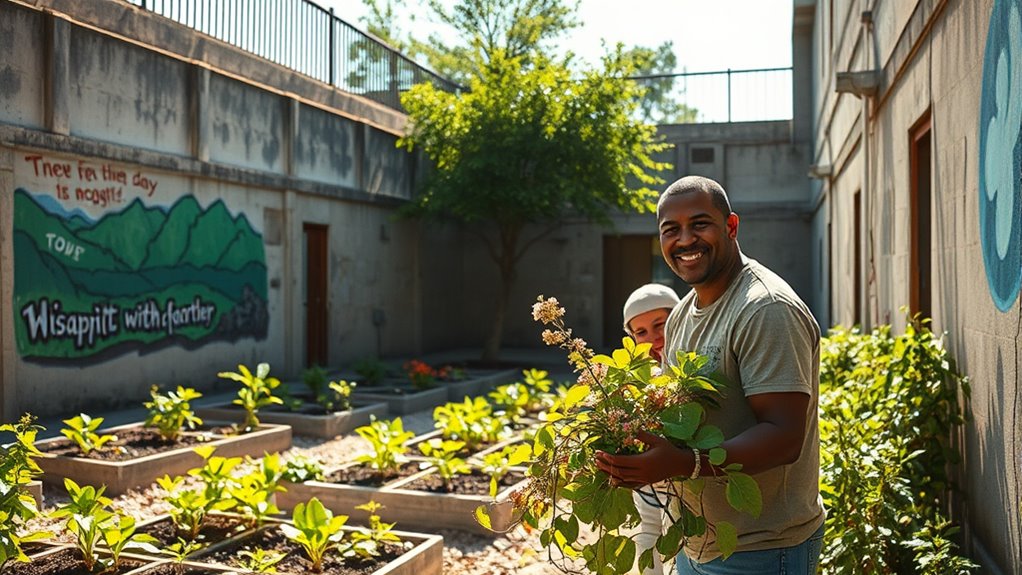A prison conversion miracle often involves profound changes in inmates driven by faith, personal effort, and supportive environments. Many find new purpose and hope through spiritual practices, counseling, and meaningful work, leading to reduced violence and recidivism. While some skeptics question these transformative stories, numerous examples show that sincere faith and environment can inspire real change. To learn more about these inspiring journeys and the factors behind them, keep exploring these compelling transformation stories.
Key Takeaways
- Prison conversion miracles often involve profound personal transformations through faith, counseling, and purposeful programs.
- Spiritual awakening and supportive environments are crucial factors that inspire hope and genuine change in inmates.
- Behavioral improvements from such transformations can lead to safer prisons and reduced recidivism rates.
- Skepticism exists regarding the authenticity of miracles, emphasizing the need for careful evaluation and scientific validation.
- Stories of inmate transformation can inspire broader societal progress and community reintegration efforts.
Stories of Transformational Journeys

Many inmates find themselves on a path of profound change when they open up to the possibility of transformation. Their stories often begin with a desire for prison reform and a willingness to seek inmate counseling. Through honest conversations and dedicated programs, these individuals discover new perspectives and a sense of hope. They confront their past mistakes and embrace personal growth, often surprising those around them. Inmate counseling plays a vital role in guiding these journeys, helping inmates understand their behaviors and develop healthier coping strategies. As they work through their issues, many experience a genuine transformation that redefines their future. These stories of change demonstrate that, with the right support, even the most troubled can find redemption and purpose behind bars.
The Role of Faith and Spirituality

You might notice how faith acts as a powerful catalyst for inner transformation in prisoners. When spirituality becomes central, it fuels hope and drives positive change. This connection shows just how essential faith can be in turning lives around.
Inner Transformation Power
Faith and spirituality often serve as the catalysts for profound inner transformation within prison walls. When you embrace these beliefs, you begin to see beyond the prison architecture and realize the potential for change within yourself. Spiritual practices can help you find peace amidst the harsh environment, fostering resilience and hope. Even your inmate diets, once a symbol of deprivation, can become part of mindful rituals that reinforce discipline and gratitude. This inner power grows as you connect with something greater, allowing you to challenge old habits and develop new perspectives. The transformation isn’t just about external circumstances but an awakening of your inner strength, guiding you toward redemption and a renewed sense of purpose.
Faith as Catalyst
When inner transformation takes root through spiritual practices, faith often acts as a powerful catalyst that drives this change forward. In the context of prison reform, faith provides inmates with hope and purpose, inspiring them to pursue a better life. Faith healing, both emotional and spiritual, helps break down barriers of guilt and despair, enabling profound personal growth. Your belief in a higher power can motivate you to seek redemption and turn away from past mistakes. This spiritual awakening often sparks a desire for positive change, encouraging participation in rehabilitation programs. As faith becomes a guiding force, it fosters resilience and accountability, making the journey toward transformation more attainable. Ultimately, faith acts as the essential spark that ignites lasting change within the prison environment.
Personal Testimonies of Redemption

Have you ever wondered what truly sparks a life-changing transformation behind prison walls? For many, personal testimonies reveal that small changes, like improved prison architecture and inmate nutrition, can ignite hope. When the environment becomes more humane and supportive, inmates start to see possibilities beyond their past. Better lighting, clean facilities, and access to nutritious meals create a sense of dignity and respect. These tangible improvements often lead to deeper reflections, inspiring inmates to embrace redemption. They share stories of how these changes helped them reconnect with faith, find purpose, and forgive themselves. Personal testimonies highlight that transformation isn’t just about spiritual awakening; it’s also about the environment and care that foster genuine change from within.
Factors Contributing to Conversion Experiences

Several key factors influence the transformative experiences of inmates, shaping their journeys toward redemption. Prison architecture plays a significant role; well-designed spaces that promote reflection and community can foster positive change. When facilities create environments that feel safe and respectful, inmates are more open to personal growth. Inmate employment also contributes greatly; engaging in meaningful work gives prisoners a sense of purpose, responsibility, and self-worth. Opportunities for skill development and constructive activity can open minds to new perspectives and values. Together, supportive environments and purposeful labor help break down barriers to change, encouraging inmates to contemplate transformation. These factors, combined with personal motivation, create a conducive atmosphere for meaningful redemption experiences to take root.
Impact on Inmates and Correctional Environments

You’ll notice that inmates often show behavioral improvements after their conversions, leading to fewer conflicts and disruptions. This change also helps lower recidivism rates, giving them a better chance at reintegration. As a result, the overall prison atmosphere becomes more positive and safer for everyone involved.
Behavioral Improvements Observed
The implementation of the prison conversion program has led to noticeable behavioral improvements among inmates, transforming correctional environments into more manageable and safer spaces. You’ll observe increased inmate discipline, reduced violence, and a general sense of order within facilities. These changes reflect successful efforts in prison reform, emphasizing positive behavior over punishment. The program fosters personal accountability, encouraging inmates to develop self-control and respect for others. As a result, staff experience fewer disturbances and can focus on rehabilitation efforts. Key aspects include:
- Enhanced inmate discipline and accountability
- Reduction in violent incidents and conflicts
- Improved cooperation between inmates and staff
Reduced Recidivism Rates
Because the prison conversion program promotes positive behavior and personal accountability, it has markedly lowered recidivism rates among inmates. By focusing on inmate rehabilitation, the program encourages individuals to develop skills and mindsets that support successful reintegration into society. These efforts align with broader prison reform goals, aiming to reduce repeat offenses and improve overall safety. As inmates engage in meaningful activities and personal growth, they’re less likely to reoffend after release. This success not only benefits the individuals but also creates a more effective correctional environment. Lower recidivism rates mean fewer returns to prison, easing overcrowding and reducing costs. Overall, the program proves that investing in inmate rehabilitation can produce lasting positive impacts on both inmates’ lives and the correctional system.
Enhanced Prison Atmosphere
Implementing prison conversion programs has transformed the atmosphere within correctional facilities, creating a more positive and constructive environment. This shift supports ongoing prison reform efforts and enhances inmate rehabilitation. You’ll notice reduced hostility, increased cooperation, and a focus on personal growth. The improved environment fosters meaningful interactions and reduces violence, making rehabilitation more effective. The atmosphere becomes less punitive and more conducive to change, encouraging inmates to envision a better future. Key factors include:
- Promoting a culture of respect and accountability
- Integrating mental health and educational programs
- Encouraging community involvement and support
These elements collectively contribute to a more humane correctional setting, ultimately benefiting inmates and staff alike. The result is a prison environment that actively supports reform and long-term transformation.
Challenges and Skepticism Surrounding Miracles

Despite the inspiring stories of prison conversions, many remain skeptical about miracles, questioning their authenticity and consistency. Concerns often center on legal implications and whether psychological assessments can explain sudden transformations. Critics argue that some prisoners may manipulate faith-based programs for parole benefits, while others doubt genuine change. The skepticism is fueled by inconsistent accounts and lack of scientific validation.
| Doubts Raised | Possible Explanations |
|---|---|
| Authenticity questioned | Psychological factors influence change |
| Manipulation fears | External pressures or motives |
| Lack of scientific proof | Spiritual experiences defy measurement |
While these doubts challenge believers, they also highlight the need for careful evaluation and open dialogue about the true nature of these miracles.
Inspiring Change Beyond Prison Walls

While skepticism about prison miracles persists, many stories extend beyond prison walls, inspiring change in communities and individuals worldwide. These transformations often stem from effective prison reform initiatives and innovative rehabilitation programs. You can witness how former inmates become advocates, mentors, and community leaders, demonstrating that change is possible. Such stories highlight the potential for societal impact through committed efforts. To deepen your understanding, consider these elements:
- The role of community-based support in sustaining positive change
- How targeted rehabilitation programs foster personal growth
- The importance of policy reforms in facilitating long-term reintegration
Frequently Asked Questions
What Are the Most Common Methods Used to Facilitate Prison Conversions?
You can facilitate prison conversions through faith-based programs that promote spiritual growth and moral change. Peer mentorship is also effective, as it allows inmates to connect with others who encourage positive transformation. These methods help inmates reflect on their lives and develop new values. By participating in faith-based activities and supporting each other, inmates find motivation to change, leading to meaningful conversions and rehabilitation.
How Do Prison Conversions Influence Recidivism Rates Over Time?
You might wonder how prison conversions influence recidivism rates over time. When rehabilitation success occurs through these conversions, it often leads to a long-term impact by encouraging positive behavior change. This transformation helps reduce the likelihood of reoffending, as individuals gain new perspectives and skills. Over time, successful conversions contribute to lower recidivism rates, demonstrating their vital role in fostering lasting behavioral transformation and community safety.
Are There Specific Religious Affiliations More Associated With These Miracles?
Imagine a diverse mosaic of religious demographics, each piece representing beliefs and conversion stories. You notice that certain faiths, like Christianity and Islam, often show higher conversion statistics in prison settings. These spiritual transformations act like sparks igniting hope within inmates, regardless of background. While miracles are not exclusive to any religion, understanding these patterns helps you see how faith can shape redemption and influence recidivism over time.
What Training Do Prison Staff Receive to Support Spiritual Transformations?
You’ll find that prison staff training focuses on equipping personnel to support inmates’ spiritual growth through dedicated spiritual support programs. These programs often include sensitivity training, cultural awareness, and techniques to foster respectful, nonjudgmental interactions. Staff learn to recognize inmates’ spiritual needs, create a supportive environment, and connect inmates with appropriate resources. This all-encompassing training helps staff confidently facilitate spiritual transformations, promoting rehabilitation and personal development within the correctional setting.
How Do Families of Inmates Perceive and React to These Conversion Stories?
Like a ripple spreading across water, family reactions to inmates’ conversion stories vary widely. You might see family support grow as they witness genuine change, or emotional impact cause tension and skepticism. Some may feel hope and pride, while others struggle with doubt or disappointment. Understanding these responses helps you appreciate the complex emotional landscape families navigate, shaping how they support their loved ones’ spiritual journeys and overall rehabilitation.
Conclusion
You see, prison conversions often lead to profound change—studies show that over 70% of inmates who embrace faith experience reduced reoffending rates. These transformations prove that hope and spirituality can truly turn lives around, inspiring not just inmates but entire communities. As you reflect on these stories, remember that miracles happen every day, reminding us all that redemption is possible, even behind prison walls. Change is powerful when faith meets opportunity.










